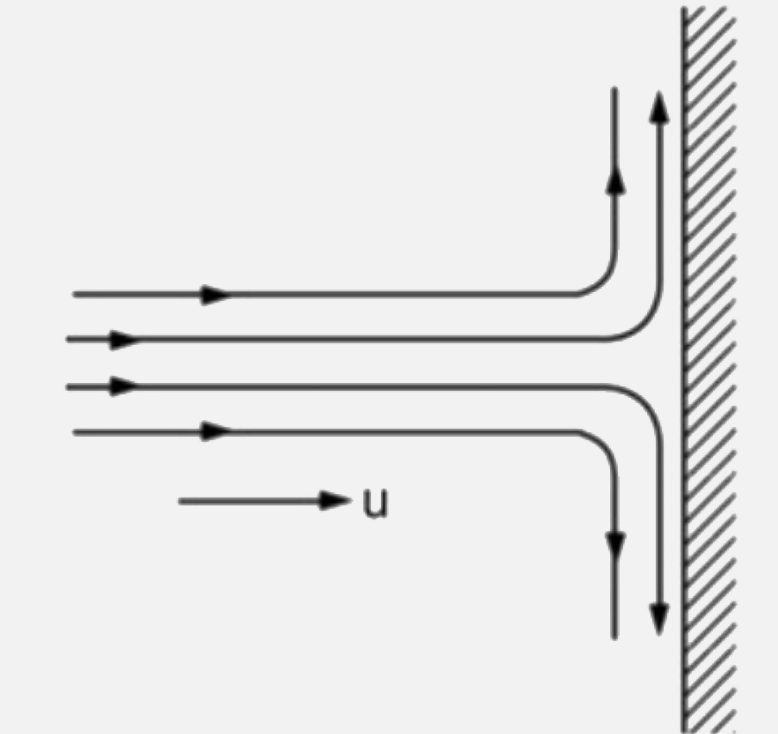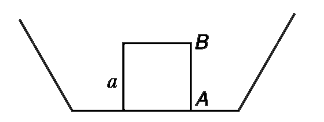A fire hydrant delivers water of density ρ at a volume are L. The water travels vertically upward through the hydrant and then does 90∘ turn to emerge horizontally at speed V. The pipe and nozzle have uniform cross-section through out. The force exerted by the water on the corner of the hydrant is

ρVL
zero
2ρVL
√2ρVL
The correct Answer is:D
Force exerted in vertical direction
and horizontal direction are
F1=F2=vrel×dmdt=Vp.L
∴Fnet=ρVL√2

Topper's Solved these Questions
- FLUID MECHANICSBook:RESONANCEChapter:FLUID MECHANICSExercise:Examples
Explore 22 Videos
- FLUID MECHANICSBook:RESONANCEChapter:FLUID MECHANICSExercise:Board Level Exercise
Explore 18 Videos
- ELECTROSTATICSBook:RESONANCEChapter:ELECTROSTATICSExercise:Exercise
Explore 52 Videos
- FULL TEST 1Book:RESONANCEChapter:FULL TEST 1Exercise:Exercise
Explore 30 Videos
Similar Questions
Water flows through a pipe bent at an angle α to the horizontal with velocity v . Calculate the force exerted by the water on the bend of the pipe of area of cross - section S .
View Solution_S01_083_Q01.png)
Water (density ρ) is flowing through the uniform tube of cross-sectional area A with a constant speed v as shown in the figure. Find the magnitude of force exerted by the water on the curved corner of the tube is (neglect viscous forces)
View Solution
Knowledge Check
A fire hydrant delivers water of density ρ at a volume are L. The water travels vertically upward through the hydrant and then does 90∘ turn to emerge horizontally at speed V. The pipe and nozzel have uniform corss-section throught out. The force exerted by the water on the corner of the hydrant is
 AρVLBzeroC2ρVLD√2ρVL
AρVLBzeroC2ρVLD√2ρVLWater is flowing through a horizontal pipe of non-uniform cross- section. At the extreme narrow portion of the pipe, the water will have
AMaximum speed and least pressureBMaximum pressure and least speedCBoth pressure and speed maximumDBoth pressure special leastA horizontal pipe of cross-section diameter 5cm carries water at a speed of 4ms−1. The pipe is connected to a smaller pipe with a cross-sectional diameter 4cm. The velocity of water through the smaller pipe is
A6.25ms−1B5.0ms−1C3.2ms−1D2.56ms−1
A stream of water of density ρ, cross sectional area A, and speed u strikes a wall that is perpendicular to the direction of the stream, as shown in the figure below. The water then flows sideways across the wall. The force exerted by the stream on the wall is

View Solution(i) A non uniform cube of side length a is kept inside a container as shown in the figure. The average density of the material of the cube is 2 ρ where ρ is the density of water. Water is gradually fille din the container. It is observed that the cube begins to topple, about its edge into the plane of the figure passing through pointA, when the height of the water in the container becomes a2. Find the distance of the centre of mass of the cube from the face AB of the cube. Assume that water seeps under the cube.

(ii) A rectangular concrete block (specific gravity =2.5) is used as a retatining wall in a reservoir of water. The height and width of the block are x and y respectively the height of water in the reservoir is z=34x. the concrete block cannot slide on the horizontal base but can rotate about an axis perpendicular to the plane of the figure and passing through point A

(a) Calculate the minimum value of the ratio yx for which the block will not begin to overturn about A.
(b) Redo the above problem for the case when there is a seepage and a thin film of water is present under the block. Assume that a seal at A prevents the water from flowing out underneath the block.
View SolutionA liquid of density ρ is flowing with a speed v through a pipe of cross sectional area A. The pipe is bent in the shape of a right angles as shown. What force should be exerted on the pipe at the corner to keep it fixed?

View SolutionA liquid of density ρ flows along a horizontal pipe of uniform cross - section A with a velocity v through a right angled bend as shown in Fig. What force has to be exerted at the bend to hold the pipe in equilibrium ?
View SolutionThe figure bwlow indicates flow of water through a tube of uniform cross-section with a constant speed in the direction as shown by the arrows. On the tube, water exerts

View Solution
